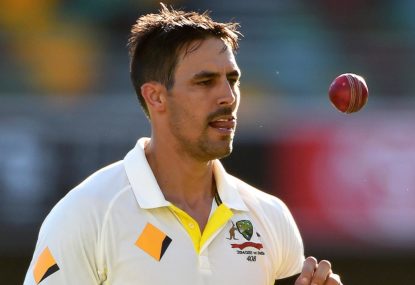Australia appeared to have faltered by fielding four pace options on a dry, utterly lifeless pitch in Wednesday night’s first Test against the West Indies.
In the opening over, armed with a hard, new ball, Australia’s fastest bowler Mitchell Johnson struggled to get his deliveries even to carry to the keeper.
In the 16th over, tweaker Nathan Lyon got the ball to turn alarmingly, inducing a fatal edge from Darren Bravo.
FULL AUSTRALIA vs WEST INDIES SCORECARD
Combined, these two circumstances seemed to be strong evidence the selectors had made a blunder.
The parched, slow and low pitch came as no surprise. Windsor Park in Dominica is beloved by slow bowlers in the West Indies domestic competitions and tweakers have run amok in the few Tests played there.
Over the past two Tests at the ground, spin bowlers dominated, taking 47 wickets, which amounted to a whopping 71 per cent of dismissals.
When Australia last played at Roseau in 2012, 26 wickets were taken by spinners, compared to just twelve for the quicks, despite the fact both teams fielded three specialist fast bowlers.
Again on Wednesday, both teams went with just one spinner. The West Indies had a more obvious reason: they don’t even have one slow bowler of Test standard. Lyon receives regular criticism in Australia but the Windies would rejoice were they somehow able to acquire his services.
Leg spinner Fawad Ahmed may not have lit up the tour match last week, but he is coming off a wonderful Sheffield Shield season and is a vastly experienced bowler. If he cannot get a game on a pitch which suits spinners as much as any other Test strip in the world, the selectors must not have complete faith in his skills.
It was a vote of no confidence in Ahmed from the Australian hierarchy. It seems that, unless Lyon’s game completely falls apart, we are unlikely to see the Pakistani refugee make an inspiring debut any time soon.
Of course, bashing the selectors is a popular pastime. Despite the surface hindering their pace-heavy attack, Australia flourished.
The Mitchells, Johnson and Starc, were both well below their best but Josh Hazlewood was sublime. A bowler built for hard, responsive pitches, the lofty right-armer managed to adapt remarkably well to the soporific deck, as he had done in the warm-up match.
Maintaining a fuller line than his pace counterparts, he regularly drew the batsmen forward, getting them to grope at deliveries pitched just outside off stump. It was a masterful display from such a young bowler.
Hazlewood regularly has been compared with Australian legend Glenn McGrath. The champion seamer was hugely effective at home but was at his most valuable on sleepy foreign pitches, worrying batsmen when others couldn’t.
Hazlewood was truly reminiscent of McGrath on Wednesday night, extracting every skerrick of assistance from the barren surface and constantly testing the technique and temperament of his foes.
As for the selectors, they deserve credit when they get things right and that is just what they’ve done by promoting Steve Smith. Number three has been the side’s biggest weakness since the demise of Ricky Ponting as a world-class player five years ago.
An array of batsmen have tried and failed to make that position their own. Shane Watson, Rob Quiney, Ed Cowan, David Warner, Usman Khawaja, Michael Clarke, Phil Hughes, Glenn Maxwell, Alex Doolan – none have gone close to bedding down the spot.
Meanwhile, Smith has blossomed into the side’s most rounded batsman and one of the truly elite players in world cricket. Having turned 26 years old on Tuesday, he is still a year or two away from the age at which batsmen typically reach their peak.
He has the advantage of taking on the most pivotal position in the batting line-up while overflowing with confidence and form. All of those nine aforementioned batsmen who went before him either looked uncomfortable or overawed at first drop.
It is a long time since Smith has exhibited either of those unattractive attributes. Crucially, he has done much of his best work as a rescue artist coming to the aid of his side in the wake of batting collapses.
He absorbs pressure like a pressure-absorbing sponge designed to… you get the picture. Now he will have the opportunity to head off calamities rather than seeking to rectify them.
Smith is equally at ease whether starting his innings in an assertive fashion to maintain his side’s ascendancy, or in a sedate, cautious manner to halt the march of the opposition attack.
He can shift gears in his batting seamlessly, an attribute which is often overlooked when assessing the quality of a Test batsman.
This is one of the hallmarks of a great first drop. Finally, Australia have a number three who evokes confidence.





























































































